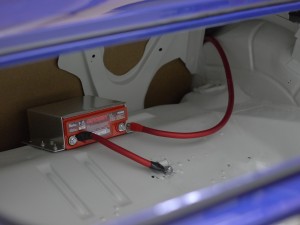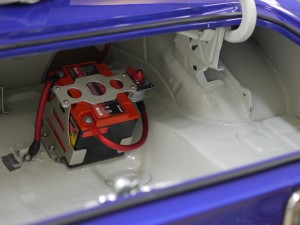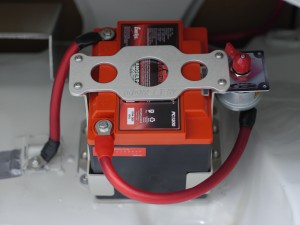Bigger battery and cutoff switch installed + weight placement musings
In the process of getting the car wired I must have left things in a slightly draining state overnight, which killed the Odyssey PC680 battery originally installed:
Which is a bummer, I’d hoped that thing would last a while. I let it charge for a long time using a good charger, but it failed to come back to life, and had difficulty getting the motor to turn over back on the day I first drove it.
Not wanting to have those kind of hassles when it “matters”, at an actual event, or somewhere out on the street, elected to get a much larger battery, until something like Nationals, when the 34lb. weight savings will be most meaningful.
So in went an Odyssey PC1200, a substantially higher-capacity unit. Still the same AGM technology allowing it to be mounted in any orientation.
Not quite enough room to mount it up on the “shelf” where the PC680 went, it ended up a little further back, to the right, and lower.
Also installed a battery cut-off switch. This will ensure the battery isn’t being drained when the car is not in use.
Left the old battery hold-down in place, this way I can swap to the 4lb. battery in about 5 minutes if desired.
Where should I put my battery?
Anybody building a car for a class that allows one to move the battery, likely ends up asking themselves this question at one time or another.
In some cases, advances in modern battery technology have allowed for such compact and lightweight batteries, you almost don’t even need to worry about it. There are batteries out there literally under 2 pounds, that can start small 4-cylinder engines. If the other needs of the electrical system can tolerate a battery like this, there is little to gain from moving it from wherever it was stock, assuming it is already pretty close to the starter.
For cars with bigger engines, or cars that have more demanding electrical requirements, the battery will end up having a significant impact on the static front:rear weight distribution of the car.
Let’s take an example 3000lb. car with front weight of 1600lbs. (53.33%) and rear weight of 1400lbs. (46.66%). Say this car has a 30lb. battery right at the front axle line, and we move it to the rear axle line.
Front weight is now 1570 (52.33%), rear weight 1430 (47.66%). That’s a whopping 1% shift in static weight distribution, just by moving the battery!
The reality too, with a car like this Camaro, is the battery starts out about 18″ in front of the front axle, and ends up a bit behind the rear, having more than a 1% effect (assuming those weights are about right).
A lot of people fuss over engine setback, and go to great lengths with firewall modification, custom motor and trans mounts, driveshafts, etc., to get the motor back another 1-2″. While those aren’t necessarily bad ideas for classes that allow it, moving 600lbs. rearward 1-2″, is only about 1/6th as helpful, as moving the battery to the trunk (11 feet or more in a Camaro).
If moving it rearward is good, why do I have it where it is, just about as far forward in the trunk as possible? There is room to go rearward another 2 feet or so?
While doing so would improve the appearance of the static weight distribution numbers, the picture above tells the tale.
Weight placed beyond the axles (ahead of the front, behind the rear) has some negative effects, at least for a car that expects to turn corners.
While placing the battery further back does put more weight on the rear tires (a good thing, especially at launch time), it takes load off the front tires – without actually reducing the amount of mass the front tires have to haul around the corner. The rear axle acts like the fulcrum in a teeter-totter; the further away from the fulcrum, the more leverage the battery’s weight has in “lifting” the front axle. This is a very important thing to keep in mind – while we might feel good about the lower registered front axle weight on a set of corner balancing scales as we move the battery further and further behind the rear axle, what we’re really doing is taking away some of the load those tires deserve to get, load which would add to front grip. While it is true (harken back to the CVD series for more on this) that a tire is more efficient (more grip per unit of load) when more lightly loaded, it still produces less total grip when more lightly loaded.
This is one of two reasons why weight/mass located outside of the vehicle’s wheelbase is a bad thing. The other, is that it tends to increase the polar moment of inertia – which may be okay for a Bonneville car that needs to be arrow-stable, but autocross is at the other end of the extreme, where a car’s ability to quickly rotate is paramount.
With this in mind, there are lots of micro decisions about where to place things in a car. Obviously there are requirements that things be usable, and reliable, and serviceable, but beyond that – when you have some genuine freedom on where to place things – here’s what I use to take creativity and aesthetics out of the equation:
- It should be as low as possible. This minimizes CG height which aids in cornering and braking.
- It should be as far rearward as possible, without being behind the rear axle. This puts more weight on the drive tires (for RWD), and helps unburden the front, without introducing the teeter-totter/lever effect described above. Some already heavily rear-biased cars, like a Porsche 911, may be exceptions to this.
- It should be as close to axle center line as possible. This helps reduce polar moment further. If you imagine looking at a car from above, it would be easier to rotate a car with its mass centered at the shifter, vs. one where the mass is all in the doors.
Obviously few things are as heavy as the car’s battery, but a lot of what makes a really fast car fast, is the incremental contribution of a large number of very small things. In this case, placing every other little thing you can a bit lower and a bit further back, could end up leading to that extra thousandth or hundredth of a second that separates first from second.
In the case of this Camaro, with ultimate freedom, I’d probably run the 4lb. battery where the passenger’s feet go (allowing for super-short cables), and with the big battery, would run it where the right rear seat bottom is. But since we can’t have the battery in the “passenger compartment” in Street Touring, instead chose to mount it just about as far forward in the trunk as possible. It could have gone more rearward which would have the benefit of making it lower and improving the appearance of static weight distribution, but the negative effect on front tire loading is something I wished to minimize, particularly in light of these cars’ known penchant for push.
The other big question mark is fuel level – the difference between full and low fuel levels is probably 80lbs., and it’s all back behind the rear axle. If I can find a way to run it with a low tank, it could have benefits on handling well beyond the pure weight saving element.
Oh, since I know everyone is anxious to see the Rhoades Camaro out dodging cones, here is the young Rhoades showing dad how it’s done 🙂





Leave a Reply
You must be logged in to post a comment.